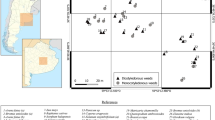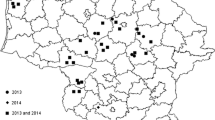Abstract
Toxigenic Fusarium species are common pathogens of wheat and other cereals worldwide. In total, 449 wheat heads from six localities in Poland, heavily infected with Fusarium during 2009 season, were examined for Fusarium species identification. F. culmorum was the most common species (72.1% on average) with F. graminearum and F. avenaceum the next most commonly observed, but much less frequent (13.4 and 12.5% respectively). F. cerealis was found in 1.8% of all samples, and F. tricinctum was found only in one sample (0.2%). Subsequent quantification of the three major mycotoxins (deoxynivalenol, zearalenone and moniliformin) in grain and chaff fractions with respect to associated prevailing pathogen species uncovered the following patterns. Moniliformin (MON) was found in low amounts in all samples with F. avenaceum present. In contrast, deoxynivalenol (DON) and zearalenone (ZEA) were the contaminants of F. culmorum- and F. graminearum-infected heads. The highest concentration of DON was recorded in grain sample collected in Radzików (77 µg g−1). High temperatures in Central Poland during July and August accompanied with high rainfall in July were responsible for this high DON accumulation. Trichothecene, zearalenone, enniatin and beauvericin chemotypes were identified among 21 purified isolates using gene-specific PCR markers.
Similar content being viewed by others
References
Bottalico A., Fusarium diseases of cereals, species complex and related mycotoxin profiles in Europe, J. Plant Pathol., 1998, 80, 85–103
Bottalico A., Perrone G., Toxigenic Fusarium species and mycotoxins associated with head blight in small-grain cereals in Europe, Eur. J. Plant Pathol., 2002, 108, 611–624
Boutigny A.L., Ward T.J., Van Coller G.J., Flett B., Lamprecht S.C., O’Donnell K., et al., Analysis of the Fusarium graminearum species complex from wheat, barley and maize in South Africa provides evidence of species-specific differences in host preference, Fungal Genet. Biol., 2011, 48, 914–920
Paterson R.R.M., Lima N., How will climate change affect mycotoxins in food?, Food Res. Int., 2010, 43, 1902–1914
Stępień Ł., Chełkowski J., Fusarium head blight of wheat: pathogenic species and their mycotoxins, World Mycotox. J., 2010, 3, 107–119
Talas F., Parzies H.K., Miedaner T., Diversity in genetic structure and chemotype composition of Fusarium graminearum sensu stricto populations causing wheat head blight in individual fields in Germany, Eur. J. Plant Pathol., 2011, 131, 39–48
Audenaert K., Van Broeck R., Bekaert B., De Witte F., Heremans B., Messens K., et al., Fusarium head blight (FHB) in Flanders: population diversity, inter-species associations and DON contamination in commercial winter wheat varieties, Eur. J. Plant Pathol., 2009, 125, 445–458
Spanic V., Lemmens M., Drezner G., Morphological and molecular identification of Fusarium species associated with head blight on wheat in East Croatia, Eur. J. Plant Pathol., 2010, 128, 511–516
Jestoi M., Emerging Fusarium-mycotoxins fusaproliferin, beauvericin, enniatins, and moniliformin — a review, Crit. Rev. Food Sci. Nutr., 2008, 48, 21–49
Uhlig S., Jestoi M., Parikka P., Fusarium avenaceum — the North European situation, Int. J. Food Microbiol., 2007, 119, 17–24
Pereyra S.A., Dill-Macky R., Colonization of the residues of diverse plant species by Gibberella zeae and their contribution to Fusarium head blight inoculum, Plant Dis., 2008, 92, 800–807
Xu X., Effects of environmental conditions on the development of Fusarium ear blight, Eur. J. Plant Pathol., 2003, 109, 683–689
Chełkowski J., Gromadzka K., Stępień Ł., Lenc L., Kostecki M., Berthiller F., Fusarium species, zearalenone and deoxynivalenol content in preharvest scabby wheat heads from Poland, World Mycotox. J., 2012, 5, 133–141
Goliński P., Waśkiewicz A., Gromadzka K., Mycotoxins and mycotoxicoses under climatic conditions of Poland, Polish J. Vet. Sci., 2009, 12, 581–588
Goliński P., Waśkiewicz A., Wiśniewska H., Kiecana I., Mielniczuk E., Gromadzka K., et al., Reaction of winter wheat (Triticum aestivum L.) cultivars to infection with Fusarium spp.: mycotoxin contamination in grain and chaff, Food Addit. Contamin., 2010, 27, 1015–1024
Waśkiewicz A., Beszterda M., Goliński P., Occurrence of fumonisins in food — An interdisciplinary approach to the problem, Food Control, 2012, 26, 491–499
Boenisch J.M., Schäfer W., Fusarium graminearum forms mycotoxin producing infection structures on wheat, BMC Plant Biol., 2011, 11, 110
Pfohl-Leszkowicz A., Chekir-Ghedira L., Bacha H., Genotoxicity of zearalenone, an estrogenic mycotoxin: DNA adduct formation in female mouse tissues, Carcinogenesis, 1995, 16, 2315–2320
Shier W.T., Shier A.C., Xie W., Mirocha C.J., Structure-activity relationships for human estrogenic activity in zearalenone mycotoxins, Toxicon, 2001, 39, 1435–1438
Shepard G.S., Determination of mycotoxins in human foods, Chem. Soc. Rev., 2008, 37, 2468–2477
Nirenberg H.A., A simplified method for identifying Fusarium spp. occurring on wheat, Can. J. Bot., 1981, 59, 1599–1609
Kwaśna H., Chełkowski J., Zajkowski P., Fusarium (Sierpik), In: Mycota [Grzyby], Wydawnictwo IB PAN, Warszawa-Kraków, Poland, vol. XXII, 39–111 (in Polish)
Waśkiewicz A., Stępień Ł., Mycotoxins biosynthesized by plant-derived Fusarium isolates, Arch. Indust. Hyg. Toxicol., 2012, 63, 479–488
Tomczak M., Wiśniewska H., Stępień Ł., Kostecki M., Chełkowski J., Goliński P., Deoxynivalenol, nivalenol and moniliformin occurrence in wheat samples with scab symptoms in Poland (1998–2000), Eur. J. Plant Pathol., 2002, 108, 625–630
Sharman M., Gilbert J., Chełkowski J., A survey of occurrence of the mycotoxin moniliformin in cereal samples form sources worldwide, Food Addit. Contamin., 1991, 8, 459–466
Visconti A., Pascale M., Determination of zearalenone in corn by means of immunoaffinity clean-up and high-performance liquid chromatography with fluorescence detection, J. Chromatogr. A, 1998, 815, 133–140
Thrane U., Occurrence of Fusarium and mycotoxins within the Nordic and Baltic countries, Bioforks, 2010, 5, 6
Goliński P., Kostecki M., Lasocka M., Wiśniewska H., Chełkowski J., Kaczmarek Z., Moniliformin accumulation and other effects of Fusarium avenaceum (Fr.) Sacc. on kernels of winter wheat cultivars, J. Phytopathol., 1996, 144, 495–499
Isebaert S., De Saeger S., Devreese R., Verhoeven R., Maene P., Heremans B., Mycotoxinproducing Fusarium species occurring in winter wheat in Belgium (Flanders) during 2002–2005, J. Phytopathol., 2009, 157, 108–116
Gromadzka K., Chełkowski J., Stępień Ł., Goliński P., Occurrence of zearalenone in wheat and maize grain in Poland, Cereal Res. Commun., 2008, 36B, 361–363
Chandelier A., Nimal C., Andre F., Planchon V., Oger R., Fusarium species and DON contamination associated with head blight in winter wheat over a 7-year period (2003–2009) in Belgium, Eur. J. Plant Pathol., 2011, 130, 403–414
Baturo-Cieśniewska A., Suchorzyńska M., Verification of the effectiveness of SCAR (sequence characterized amplified region) primers for the identification of Polish strains of Fusarium culmorum and their potential ability to produce B-trichothecenes and zearalenone, Int. J. Food Microbiol., 2011, 148, 168–176
Stępień Ł., Gromadzka K., Chełkowski J., Polymorphism of mycotoxin biosynthetic genes among Fusarium equiseti isolates from Italy and Poland, J. Appl. Genet., 2012, 53, 227–236
Stępień Ł., Waśkiewicz A., Sequence divergence of the enniatin synthase gene in relation to production of beauvericin and enniatins in Fusarium species, Toxins, 2013, 5, 537–555
Nicholson P., Simpson D.R., Weston G., Rezanoor H.N., Lees A.K., Parry D.W., et al., Detection and quantification of Fusarium culmorum and Fusarium graminearum in cereals using PCR assays, Physiol. Mol. Plant Pathol., 1998, 53, 17–37
Doohan F.M., Parry D.W., Jenkinson P., Nicholson P., The use of species-specific PCR-based assays to analyze Fusarium ear blight of wheat, Plant Pathol., 1998, 47, 197–205
Nicholson P., Simpson D.R., Wilson A.H., Chandler E., Thomsett M., Detection and differentiation of trichothecene and enniatin-producing Fusarium species on small-grain cereals, Eur. J. Plant Pathol., 2004, 110, 503–514
Parry D.W., Nicholson P., Development of a PCR assay to detect Fusarium poae in wheat, Plant Pathol., 1996, 45, 383–391
Kulik T., Detection of Fusarium tricinctum from cereal grain using PCR assay, J. Appl. Genet., 2008, 49, 305–311
Wilson A., Simpson D., Chandler E., Jennings P., Nicholson P., Development of PCR assays for the detection and differentiation of Fusarium sporotrichioides and Fusarium langsethiae, FEMS Microbiol. Lett., 2004, 233, 69–76
Mishra P.K., Fox R.T.V., Culham A., Development of a PCR-based assay for rapid and reliable identification of pathogenic Fusaria, FEMS Microbiol. Lett., 2003, 218, 329–332
Quarta A., Mita G., Haidukowski M., Santino A., Mulé G., Visconti A., Assessment of trichothecene chemotypes of Fusarium culmorum occurring in Europe, Food Addit. Contamin., 2005, 22, 309–315
Yoder W.T., Christianson L.M., Species-specific primers resolve members of Fusarium section Fusarium. Taxonomic status of the edible “Quorn” fungus reevaluated, Fungal Genet. Biol., 1998, 23, 68–80
Stępień Ł., Popiel D., Koczyk G., Chełkowski J., Wheat-infecting Fusarium species in Poland — their chemotypes and frequencies revealed by PCR assay, J. Appl. Genet., 2008, 49, 433–441
Ward T.J., Clear R.M., Rooney A.P., O’Donnell K., Gaba D., Patrick S., et al., An adaptive evolutionary shift in Fusarium head blight pathogen populations is driving the rapid spread of more toxigenic Fusarium graminearum in North America, Fungal Genet. Biol., 2008, 45, 473–484
Błaszczyk L., Goyeau H., Huang X., Röder M., Stępień Ł., Chełkowski J., Identification of leaf rust resistance genes and mapping gene Lr37 on microsatellite map of wheat, Cell. Mol. Biol. Lett., 2004, 9, 805–817
Mankevičienė A., Butkutė B., Gaurilčikienė I., Dabkevičius Z., Risk assessment of Fusarium mycotoxins in Lithuanian small cereal grains, Food Control, 2011, 22, 970–976
Stępień Ł., Jestoi M., Chełkowski J., Cyclic hexadepsipeptides in wheat field samples and esyn1 gene divergence among enniatin producing Fusarium avenaceum strains, World Mycotox. J., 2013, 6, (in press), DOI:10.3920/WMJ2012.1464
Šlikovà S., Šudyovà V., Gregovà E., Deoxynivalenol in wheat from growing areas of Slovakia, Cereal Res. Commun., 2008, 36, 279–287
Author information
Authors and Affiliations
Corresponding author
About this article
Cite this article
Wiśniewska, H., Stępień, Ł., Waśkiewicz, A. et al. Toxigenic Fusarium species infecting wheat heads in Poland. cent.eur.j.biol. 9, 163–172 (2014). https://doi.org/10.2478/s11535-013-0262-1
Received:
Accepted:
Published:
Issue Date:
DOI: https://doi.org/10.2478/s11535-013-0262-1




